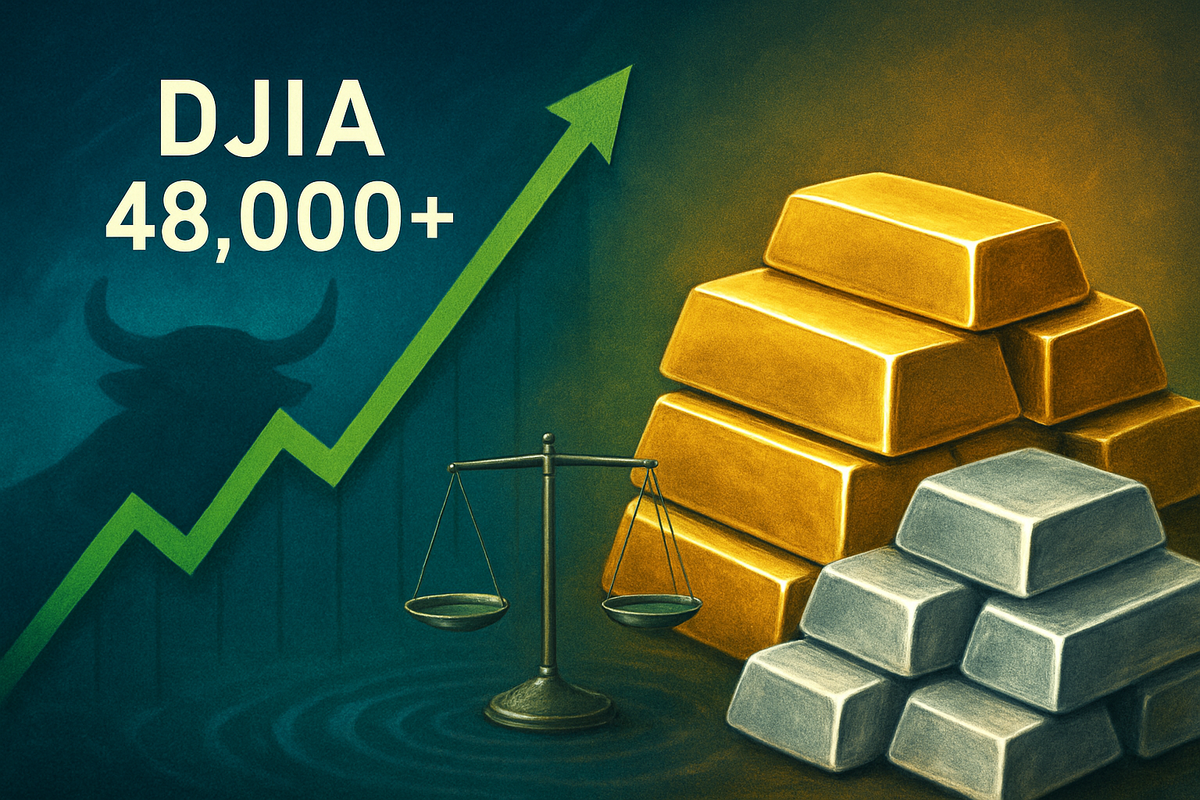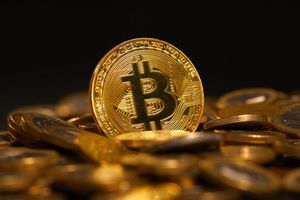
As of November 12, 2025, the global financial markets are gripped by a perplexing and historically rare phenomenon: the Dow Jones Industrial Average (DJIA) has surged beyond the 48,000-point mark, signaling robust equity performance and investor optimism, while simultaneously, gold and silver prices have skyrocketed to unprecedented levels. This unusual tandem rise of both risk-on and safe-haven assets represents a profound "tug-of-war" in investor sentiment, reflecting a complex interplay of cautious optimism and deep-seated anxiety about the future economic landscape.
This divergence challenges conventional market wisdom, where equities and precious metals typically exhibit an inverse relationship. The simultaneous ascent suggests that investors are "hedging their hope," allocating capital to both high-growth potential stocks and traditional stores of value. This intricate dance is largely fueled by an abundance of market liquidity, yet it also underscores significant concerns about persistent inflation, escalating fiscal deficits, and a potentially weakening U.S. dollar, creating an environment ripe with both opportunity and considerable risk.
The Market's Conundrum: A Detailed Look at the Anomaly
The journey to a DJIA above 48,000 has been paved by a confluence of factors. Robust corporate earnings, particularly from sectors like healthcare and technology, have instilled confidence in future economic growth. Speculation around a more dovish stance from the Federal Reserve, including anticipated interest rate cuts, has further bolstered equity appeal by lowering borrowing costs and enhancing the present value of future earnings. An ongoing AI-driven capital expenditure cycle has also provided a significant tailwind, alongside optimism surrounding political stability. This sustained rally, however, has pushed equity valuations to elevated levels, raising concerns about potential market froth and the sustainability of current growth trajectories.
Concurrently, the meteoric rise of gold, surpassing $4,100 per ounce, and silver, peaking above $51-$53 per ounce, tells a different story. This surge is primarily driven by persistent inflationary concerns, as investors seek traditional hedges against the erosion of purchasing power. Falling real interest rates, where nominal rates struggle to keep pace with "sticky" inflation, make non-yield-bearing assets more attractive. Heightened global geopolitical instability and underlying economic uncertainties also fuel demand for safe havens. Furthermore, a depreciating U.S. dollar makes dollar-denominated precious metals more affordable for international buyers, while central banks globally continue to accumulate gold at multi-decade highs, reinforcing its status as a foundational asset. Silver's rally is amplified by its dual role as both a monetary asset and an industrial metal, benefiting from strong industrial demand and tight supply. This "unusual tandem rise" points to an "unclear economic outlook," where the market is grappling with contradictory signals about what lies ahead.
Corporate Fortunes in a Divergent Market
In this bifurcated market, certain public companies are poised to win, while others face significant headwinds. Precious metals mining companies stand as clear beneficiaries. Firms like Barrick Gold (NYSE: GOLD) and Newmont Corporation (NYSE: NEM) are likely experiencing substantial boosts in profit margins due to the soaring prices of their primary products. Increased revenues from higher gold and silver prices will translate directly into improved earnings, potentially leading to increased capital expenditure in exploration and production, and enhanced shareholder returns. Similarly, silver miners such as Pan American Silver Corp. (NASDAQ: PAAS) and Hecla Mining Company (NYSE: HL) will also see their bottom lines swell, benefiting from both the monetary and industrial demand for silver.
On the other hand, companies heavily reliant on consumer discretionary spending or those with high debt loads might face challenges if the underlying economic anxieties manifest into a broader slowdown. While the DJIA's ascent suggests broad market strength, an overvalued equity market can be precarious. Growth stocks, particularly those with high Price-to-Earnings (P/E) ratios, could be vulnerable to corrections if growth expectations are not met or if a shift in investor sentiment favors value over growth. Financial institutions might also face a complex environment; while a strong stock market can boost their asset management divisions, persistent inflation and potential interest rate volatility could squeeze lending margins or impact bond portfolios. Furthermore, companies with significant exposure to a weakening U.S. dollar but without corresponding international revenue streams might see their import costs rise, impacting profitability. This market anomaly underscores the importance of a company's balance sheet strength and its ability to navigate both inflationary pressures and potential market volatility.
Broader Implications and Historical Parallels
This unprecedented market divergence carries significant wider implications, signaling a profound shift in investor psychology and economic fundamentals. The simultaneous surge in equities and precious metals suggests a pervasive "debasement trade," where investors are actively seeking hard assets as a hedge against concerns about expanding fiscal deficits and the potential dilution of fiat currencies by governments worldwide. This trend fits into broader industry concerns about stagflation – a period of high inflation combined with stagnant economic growth – even as equity markets celebrate perceived growth.
The ripple effects are far-reaching. In the commodities markets, the strength of gold and silver could pull other hard assets higher, particularly industrial metals, if the underlying demand is robust. However, it also signals a potential rotation away from traditional fixed-income investments, as bonds struggle to offer real returns in an inflationary environment. Currency markets are also directly impacted, with a weakening U.S. dollar being a key catalyst for precious metals' ascent, which in turn could influence trade balances and international investment flows. Regulatory bodies and central banks, particularly the Federal Reserve, face a formidable challenge. Traditional monetary policy tools designed to either cool inflation or stimulate growth become more complex when both inflation hedges and growth assets are simultaneously rallying. Policymakers must navigate strong equity performance alongside clear signals of inflation and uncertainty, complicating decisions regarding interest rates and quantitative easing. Historically, periods of significant divergence, such as the late 1970s or early 2000s, often preceded significant market adjustments, highlighting the unsustainability of such contradictory signals over the long term. While the specifics of this anomaly are unique, the underlying tension between inflation and growth concerns echoes past periods of economic uncertainty.
Navigating the Path Ahead: What Comes Next
Looking ahead, the market's current state of "spinning two plates" suggests a period of heightened volatility and potential re-calibration. In the short term, investors should anticipate continued price swings as the market attempts to reconcile these conflicting signals. A critical factor to watch will be central bank rhetoric and actions. Any unexpected hawkish turn by the Federal Reserve, or a significant withdrawal of the "excessive liquidity" that has fueled both rallies, could trigger a sharp correction in equities or a temporary pullback in precious metals. Conversely, continued dovishness or further fiscal expansion could sustain the current divergence, albeit with increasing underlying risks.
In the long term, companies and investors must adapt to an environment where traditional correlations may no longer hold. Strategic pivots for corporations might involve strengthening balance sheets, hedging against currency fluctuations, and focusing on operational efficiencies to mitigate inflationary pressures. For investors, diversification becomes paramount, emphasizing a balanced portfolio that includes tangible assets like precious metals, alongside carefully selected equities, to manage systemic risk. Market opportunities may emerge in sectors that can effectively pass on rising costs to consumers or those that benefit from continued demand for safe-haven assets. Challenges will include navigating potential asset bubbles and the risk of a synchronized downturn if the underlying economic anxieties eventually outweigh the growth optimism. Potential scenarios range from a gradual convergence of asset classes as economic clarity emerges, to a sharp correction in one or both, or even a prolonged period of this unusual divergence, necessitating a fundamental rethinking of investment strategies.
Comprehensive Wrap-Up: A Market at a Crossroads
The unprecedented market anomaly of the Dow Jones Industrial Average breaching 48,000 while gold and silver prices soar is a defining characteristic of the financial landscape on November 12, 2025. Key takeaways include the presence of conflicting investor sentiments, driven by both strong corporate performance and deep-seated concerns over inflation, geopolitical instability, and fiscal expansion. This "hedging of hope" is primarily enabled by an abundance of liquidity within the financial system.
Moving forward, the market is at a crossroads. The sustainability of this divergence is questionable, and a re-calibration seems inevitable, though its timing and magnitude remain uncertain. Investors should remain vigilant, continuously assessing the underlying economic fundamentals and geopolitical developments. The reinforced role of precious metals as essential stores of value and hedges against inflation is a significant lasting impact, pushing them firmly into mainstream investment discussions. What investors should watch for in the coming months includes central bank policy shifts, particularly regarding interest rates and liquidity, inflation data, and any significant changes in global geopolitical tensions. The market's ability to reconcile these contradictory signals will ultimately determine its direction and the lasting impact of this extraordinary period.
This content is intended for informational purposes only and is not financial advice





